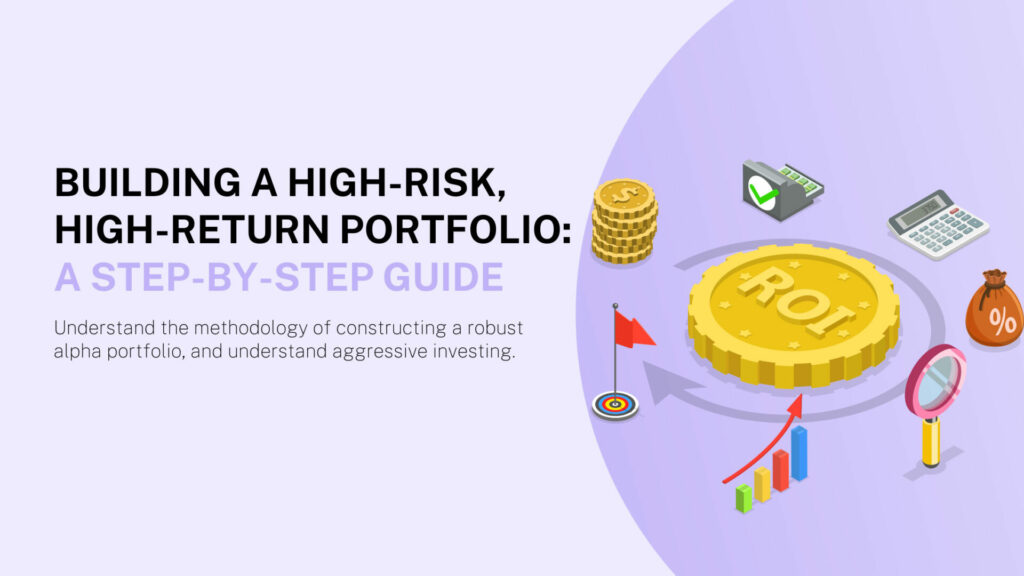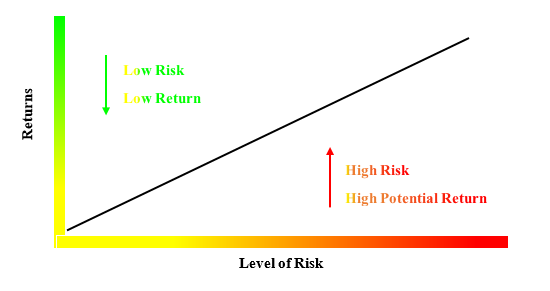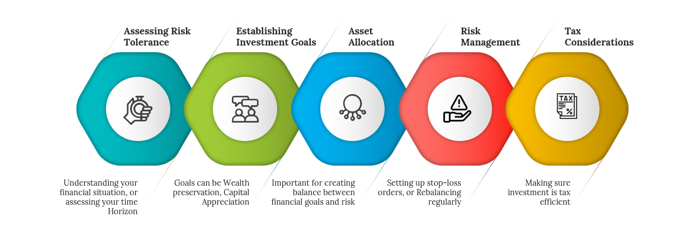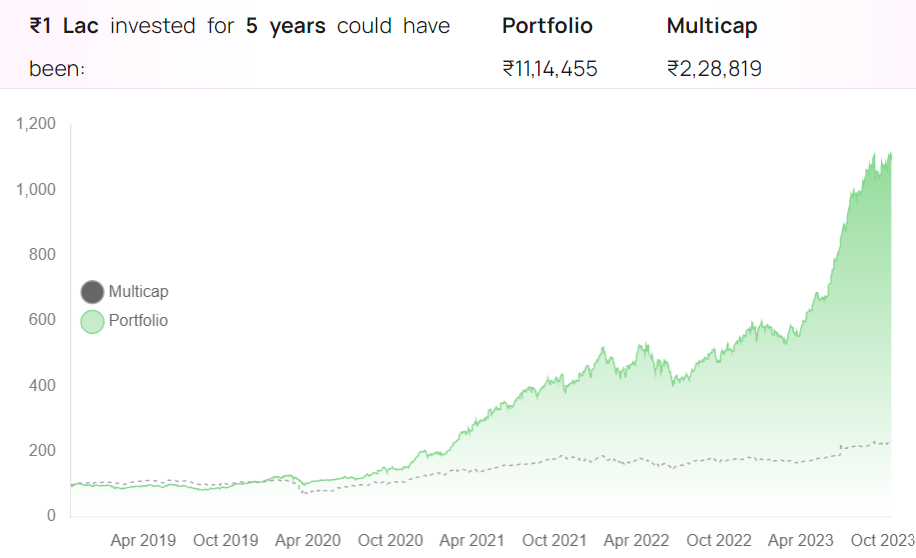Building a High-Risk, High-Return Portfolio: A Step-by-Step Guide

Getting high returns sounds appealing, but discussing profits without discussing the risk involved is pointless. In general, high gains come with a considerable risk. A high-risk investment has either a high percentage likelihood of financial loss or underperformance or a comparatively high chance of a catastrophic failure. They are only appropriate for experienced investors who understand the dangers and are willing to lose the entire investment. In this essay, we will go over what High-Risk, High-Return investing is all about. We will also discuss how to construct high-risk, high-return portfolios and the considerations to consider when investing in them.
Understanding High-Risk, High-Return Investing

The risk-reward trade-off is vital to high-risk, high-return investing. It means a direct relationship exists between the level of risk an investor is willing to take and the potential reward. High-return investments have a higher risk of loss. On the other hand, they have a higher chance of profit. As a result, they are uncertain. These investments are frequently more volatile, which means that their prices can move dramatically in a short period. This volatility can result in both significant gains and large losses. To better comprehend this concept, consider the characteristics of high-risk/ high-return investments..
- They target a high rate of return.
- There is a greater likelihood of loss
- They are more volatile than lower risk equivalents. They are often dependent on market confidence. In periods of economic uncertainty, they tend to fluctuate even more.
How to Build High-Risk, High-Return Alpha Portfolio

1. Assessing Your Risk Tolerance
Assessing your risk tolerance in high-risk, high-return investing is a crucial first step in determining whether this investment strategy is suitable for you and how to approach it.
2. Establishing Clear Investment Goals
To ensure that one is capable of handling these risky portfolios, one must identify their investment goals. They can include capital growth, income production, and asset preservation. Defining an objective is critical since it will aid in the selection of appropriate techniques. Capital appreciation is an aggressive growth strategy that is typically used in high-risk, high-return portfolios.
3. Asset Allocation Strategies
Asset allocation entails splitting your investment portfolio among several asset classes based on your financial objectives, risk tolerance, and time horizon. A higher allocation to equities (stocks) in a high-risk, high-return alpha portfolio may offer the potential for higher returns but come with more volatility. Consider allocating a smaller share to fixed-income assets such as bonds or cash, which typically have lower risk and higher returns than stocks.
4. Selecting High-Risk Investment Portfolios
Determine asset groups or specific investments with high returns track record. You can also invest in Small-cap stocks which are the shares of smaller companies with substantial growth potential but are more volatile. Another way is to invest in developing economies with the potential for significant growth but also increased political and economic dangers. Consider assets such as venture capital, cryptocurrencies, or high-risk/high-reward enterprises.
5. Research and Due Diligence
Perform extensive study on each investing possibility. This covers financial statement analysis and performance measures. Analysing the competitive landscape and the company’s place within it. Evaluating the track record and expertise of the management team. Keep up to current on market news and economic issues that may have an impact on your assets.
6. Risk Management Strategies
To protect your portfolio from substantial losses, use risk management approaches such as: Stop-Loss Orders: To limit potential losses, set specified price levels at which you will sell an investment. Diversification means spreading your investments across multiple assets to lower the risk of a single failure. Hedging: Use derivatives or options to offset future portfolio losses.
7. Monitoring and Review
Monitor your investments on a regular basis and evaluate their performance in relation to your goals. Prepare to make changes to your portfolio as market conditions or your risk tolerance change. To preserve your preferred asset allocation, consider rebalancing your portfolio on a regular basis.
8. Tax Considerations
Every investment has costs. Taxes can sting the most out of all the expenses and take the biggest bite out of your returns. Different investment types generate varying tax consequences, so make sure your investments are tax-efficient, especially in tax-advantaged accounts like IRAs
Types of High-Risk Portfolios
High-risk portfolios are investment portfolios with a higher level of risk than more conservative or balanced portfolios. The following discusses many forms of high-risk portfolios.
1. Aggressive growth portfolio
This style of investing portfolio focusses on high-growth stocks. These are often found in emerging industries or companies with significant future growth potential. These stocks are generally more volatile and tend to experience frequent price swings.
2. Small-Cap Portfolio
Small-cap stocks represent companies with smaller market capitalizations. They often have greater growth potential but are also riskier because they may lack the resources and stability of larger companies.
3. Sector Specific Portfolio
Investors may choose to concentrate their assets on recognised volatile sectors. In the Indian context, the IT business is recognised to be highly volatile because technology is a constantly evolving field with ever-increasing developments, resulting in organisations seeing rapid growth from outside clientele. Pharmaceutical and healthcare are two more sectors that have recently become more unpredictable. It has been volatile since covid-19 due to international rivalry for vaccination and regulatory changes.
4. Commodity or Natural Resource Portfolio
Commodity investing, such as gold, oil, or agricultural items, can be risky owing to price volatility and reliance on factors such as supply and demand, geopolitical events, and weather conditions.
5. Options and Derivatives Portfolio
Options and futures contracts are highly leveraged derivative transactions that can result in large gains or losses. They are often employed for hedging or speculative purposes by skilled investors.
6. Cryptocurrency Portfolio
Bitcoin and Ethereum are well-known for their high price volatility. While they have the potential for large gains, they also have a high danger of large losses.
Why Choose Wright Research Alpha prime Portfolio for High Returns?
Our Alpha Prime Portfolio is an aggressive momentum investing strategy which focuses on 10 specially chosen stocks that demonstrate strong earnings momentum and trending opportunities. This is designed for investors seeking high returns. Let’s have a look on its performance to understand about its potential for high returns. The following chart explains its performance in longer time horizon with respect to market Multicap index.

Moreover, it has live returns performance of about 38% in less than 4 months period.

Following are the key highlights of this portfolio
- Its Selected stocks demonstrate impressive momentum and potential for higher returns.
- It has potential for significant gains in bullish markets and resilience during high-risk scenarios.
- It has weekly portfolio rebalancing & high portfolio churn to seize fresh trending & emerging opportunities.
Conclusion
In this article, we’ve dived into the intriguing world of high-risk, high-return investing, looking at the methods and considerations that can help you develop a successful alpha portfolio. Whether you’re an experienced investor trying to diversify your assets or a beginner willing to take on more risk for the possibility of bigger profits, understanding the procedures involved is critical.
Remember that while high-risk, high-return investment can be beneficial, it is not without risk. It is critical to approach it with cautious planning, ongoing learning, and a readiness to adapt to changing market conditions. By following the stages and ideas provided in this guide, you may embark on your high-risk investing journey with confidence and a better chance of meeting your financial objectives.
Explore Alpha Prime smallcase here, use code PRIME25 for FLAT 25% discount on subscription fees
Disclaimer: Investment in securities market are subject to market risks. Read all the related documents carefully before investing. Registration granted by SEBI, membership of BASL (in case of IAs) and certification from NISM in no way guarantee performance of the intermediary or provide any assurance of returns to investors. Visit bit.ly/sc-wc for more disclosures.
Wryght Research & Capital Pvt Ltd•SEBI Registration No: INA100015717
103, Shagun Vatika Prag Narayan Road, Lucknow, UP 226001 IN
CIN: U67100UP2019PTC123244



























































